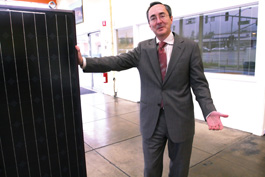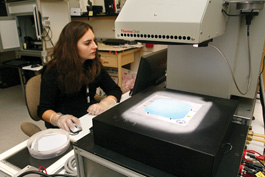home | metro silicon valley index | features | silicon valley | feature story

Photograph by Felipe Buitrago
PANEL DISCUSSION: Barry Cinnamon, CEO of San Jose's Akina Solar, thinks alternative-energy has a future in the South Bay.
Inherit the Wind
Silicon Valley is scrambling to lead the alternative energy industry, but a little-known hang-up in the federal energy bill is sabotaging our chances
By Erin Sherbert
SILICON VALLEY wants to be the capital of clean energy; in fact, many people here think it already is.
But the reality is that it's been an uphill battle to make this region an alternative-energy leader, and it won't happen if it loses solar power giants like SunPower, which is currently prepping a "Plan B" that involves pulling up stakes and investing elsewhere.
Why wouldn't the solar company consider putting their resources into Germany or Japan, two countries whose support of renewable energy has made them world leaders in the industry?
Despite political support for such energy solutions in this area, a Washington gridlock has the future of alternative energy in limbo—and the outlook is not good.
The problems are all the more surprising when you consider that clean energy is not a politically charged issue in this country; it has supporters in both the Republican and Democratic camps. Congress certainly wanted to give renewable energy its share of government money as it debated the recent federal energy bill. But what divided the parties on this issue was how to pay for the much-needed tax credits aimed at boosting the fledgling clean energy industries.
Lawmakers talked right up until the end, when the tax incentives that have kept solar and wind power growing were drop-kicked from the energy bill.
The effect could be a long-term disruption in clean energy development, with companies having no choice but to scale back on major solar and wind projects. Don't doubt that this will trickle down to Silicon Valley, a national leader in this kind of innovation.
Historically, the wind and solar industries have been plagued by spotty government support and inconsistent public policy. These are now threatening the momentum for major solar companies like San Jose–based SunPower.
President Bush touted his support for clean energy investment in America during his State of the Union speech in January. However, he put forward an economic stimulus package that didn't include extension of the renewable energy tax credits. The Senate Finance Committee attached a one-year extension to the package, hoping to get support from the full Senate, which is slated to vote on the package soon.
"The lack of extension of the tax credit has already changed our investment plan for 2008," says Julie Blunden, SunPower's vice president for public policy and corporate communications. "We would love to deploy technology here, but if we don't have long-term visibility in market development, we will have to go somewhere else."

Photograph by Felipe Buitrago
THIS LITTLE LIGHT OF MINE: Karen Wilson tests photo cells in a solar panel at SunPower in San Jose.
The Politics Of Power
A vote for renewable energy became a vote against oil companies.
It went like this: Republicans and Democrats both agreed to fund renewable energy, giving tax credits to boost the young industries. It would cost roughly $800 million in tax credits for solar and $600 billion for wind and other alternative energy projects over 10 years.
But someone would have to pay. To the Democrats, the answer was simple: Use money from the oil industry tax credits, which are estimated at three times what renewable energy receives.
But that wasn't going to work. President Bush had threatened to veto legislation that dipped into oil company tax credits. And one vote short of overriding a Republican-led filibuster on the issue, Congress caved and passed an energy bill that left out solar and wind tax credits. It also made no mention of renewable energy standards that would have mandated a certain percentage of electricity to come from renewable energy sources.
It's these tax credits that have helped the renewable energy markets prosper for the last few years, giving homeowners about $2,000 for installing solar, for starters. Commercial projects get even more generous credits, helping to produce major solar installation projects for companies such as Google.
But these credits are set to expire at the end of 2008, and unless Congress approves some extension soon, solar and wind power development will slow.
"What happened with the energy bill was really tough to swallow," says Mike Hall, president of Borrego Solar Systems, a Berkeley-based solar company. "Support for renewable energy will probably have to come at the expense of coal, oil and natural gas. It is hard to win a political battle against the combined interests of the fossil fuel industries."
"Energy is one of the highest costs people are facing now; it is on people's minds," says Monique Hanis, spokeswoman for the Solar Energy Industries Association, which has lobbied heavily to get the tax credits extended. "This has been a growth sector—you don't want to undo something that's growing well."

Photograph by Felipe Buitrago
POWERING UP: Frank Maul tests solar cells at SunPower
What, Me Worry?
Believe it or not, the United States was a leader in renewable energy, at one time. That was back in the early 1980s, after the Arab oil embargo had created widespread fear over escalating fuel prices.
California developed major windmill projects throughout the Mojave Desert. But our investment in renewable energy dissipated almost as soon as it developed. Oil prices stabilized, as did our worries that we would have to shell out more money at the pumps.
"It was short-sightedness," says Stefan Schmitz, a renewable energy expert based in London. "The underlying issue is that oil became cheaper and people didn't see the need to continue with renewable energy anymore. It was not a sexy thing on the menu."
But that has changed, particularly over the last two years, as the United States has decided to take on renewable energy, busting to become No. 1 in solar and wind production across the globe, Schmitz says.
It started with California. By 2001 the state was facing an energy crisis with rolling blackouts. Suddenly, interest in renewable energy development shifted.
California already had modest rebate programs in place at that time, but it wasn't until the state's energy crisis that lawmakers decided to establish even stronger cash rebates to encourage renewable energy usage.
Forward Thinkers
But over the last two years, global warming, the environment and never-ending high fuel prices have taken a toll on the public.
And public policy followed, taking a seismic shift when Gov. Arnold Schwarzenegger made California the bellwether of green policy. He approved A.B. 32, a major clean energy bill that elevates the state's commitment to alternative energy on all fronts.
Part of that legislation includes an aggressive solar program aimed to create 3,000 megawatts of new, solar-produced electricity by 2017. On top of that, the state last year pledged $3.2 billion for the California Solar Initiative program, with cash incentives designed to help drive down the cost of solar power systems and push solar power into the mainstream.
Silicon Valley leaders are doing their part, too. By the end of 2007, San Jose's mayor Chuck Reed practically rewrote the city's green agenda, unveiling one of the boldest plans to make San Jose a hub of clean energy development.
His plans are demanding, calling for 100 percent of electricity generated to come from renewable energy sources within 15 years; and he's making plans to create 25,000 new clean-tech jobs. Earlier this month, the mayor announced he would assist this goal by creating a clean-tech jobs investment fund.
These progressive policies have certainly paid off by luring enough investors to Silicon Valley to give it the title of clean energy capital.
Silicon Valley last year experienced the biggest boom in solar, wind and other alternative energy development, with venture capitalists investing more than $395 million in startups. That is compared to 2002, when only $6 million was put into alternative energy development here, according to the National Venture Capitalist Association.
As a result, Silicon Valley has seen some of the countries greatest advancements in solar power, particularly. Akeena Solar recently introduced a new solar panel design that reduces the cost of solar and the region is watching Nanosolar's rapid production of cutting edge solar cell technology designed to reduce the cost of solar power projects for large-scale utility projects.
"Silicon Valley will come to be known as one of the great drivers of growth of solar, but that has not yet happened," said Andrew Bebee, president of EI Solutions, a Southern California–based solar company. "I think there is a hope here and abroad that American innovation can have a seismic effect on the cost and scale of solar."
Clean and Cheap
Even if the benefits of solar and wind power are clear, conventional electricity is still much cheaper.
To overcome this, countries have worked to establish aggressive cash incentives and strong policies to make solar and wind energy more affordable for the average person.
In places such as Japan and Germany, it has worked. Together these countries account for 60 percent of the worldwide solar demand.
But the potential is here.
Nationwide, the solar and wind industries have seen record growth over the last few years, increasing capacity by as much as 45 percent in one year. The rapid increase in renewable energy injected $20 billion into the national economy last year, according to the Solar Energy Industries Association.
California, which is the largest market for solar in the United States, has also been successful in increasing solar and wind power capacity. At the same time, the state has seen very limited reduction in the cost of wind and solar, according to SolarTech, a Silicon Valley–based initiative.
"Although California has the largest solar program in the country, the commitment California has made to solar is still nowhere near what they have done in countries such as Germany and Spain," said Hall. "There are a number of exciting solar cell startups who are ahead of their Silicon Valley counterparts."
Ideally, renewable energy needs a boost with long-term tax credits, between 10 and 20 years, to help the markets prosper. It would also help if the United States required that at least 15 percent of all electricity generated come from renewable energy sources, standards that are already in place in countries such as Germany, says Kate Johnson, clean energy advocate with the Public Interest Research Group in Washington, D.C.
Johnson and other clean energy advocates are hopeful that tax credits will get slipped into future legislation sooner rather than later so that companies can deliver on major solar and wind projects that would otherwise be stalled in the pipeline.
"The clean energy industry is a highlight in what more and more people are thinking is a dismal economy," Johnson says. "If we want to keep that industry booming, we will need an extension of those tax credits."
Meanwhile, experts say it won't be long before the industry won't have to rely in such government subsidies to keep solar and wind afloat. Many believe it will be three years before the cost of solar power drops enough to make it affordable to the average homeowner.
With more solar panel manufacturers coming online and as energy prices continue to increase (by as much as 7 percent annually in California), eventually solar and wind energy will be the cheapest way to go.
"I have a hard time seeing anyone argue against clean renewable energy," says Barry Cinnamon, CEO of Akeena Solar in San Jose. "It's way better for the economy and way better than drilling for oil."
Send a letter to the editor about this story.
|
|
|
|
|
|